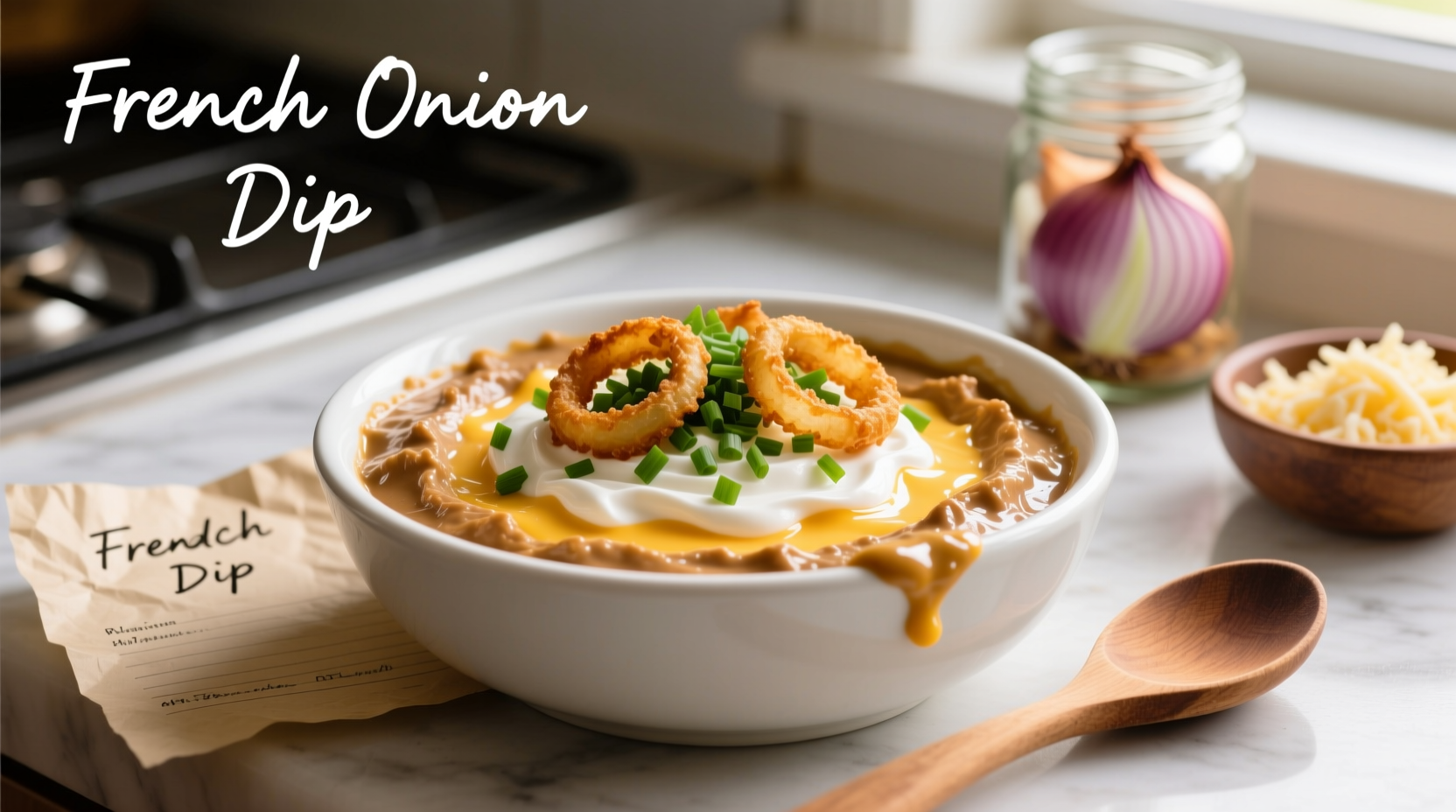Make authentic French onion dip in just 20 minutes with this simple recipe: combine 1 cup sour cream, 1 cup mayonnaise, 1 cup finely minced caramelized onions, 1 teaspoon Worcestershire sauce, and 1 minced garlic clove. Chill for 2 hours before serving for the best flavor development.
The Ultimate Guide to Perfect French Onion Dip
French onion dip isn't actually French—it was invented in 1950s California—but that doesn't make it any less delicious. This creamy, savory dip has become a staple at gatherings worldwide, and with good reason. When made properly with slowly caramelized onions rather than onion powder, it delivers complex sweet-savory flavors that elevate any snack platter.
Why This Recipe Works
Most store-bought versions rely on onion powder and artificial flavors, but the real magic happens when you take time to properly caramelize fresh onions. This chemical process transforms their natural sugars, creating over 500 flavor compounds that give authentic French onion dip its distinctive taste profile. According to culinary research from the America's Test Kitchen Science Team, proper caramelization requires at least 25-30 minutes of slow cooking to develop maximum flavor without burning.
Essential Ingredients Checklist
Gathering the right ingredients makes all the difference in achieving that perfect balance of creamy richness and savory onion flavor:
- Yellow onions (2 large) - The ideal variety for caramelization due to their sugar content
- Unsalted butter (2 tablespoons) - Helps with even browning and adds richness
- Sour cream (1 cup) - Full-fat for best texture and tang
- Mayonnaise (1 cup) - Preferably real mayonnaise, not salad dressing
- Worcestershire sauce (1 teaspoon) - Adds umami depth
- Fresh garlic (1 clove, minced) - For aromatic complexity
- Salt and freshly ground black pepper - To taste
| Ingredient Variation | Best For | Flavor Impact |
|---|---|---|
| White onions | Sharper flavor profile | More pungent, less sweet |
| Shallots | Elegant gatherings | Milder, more complex sweetness |
| Greek yogurt | Lighter version | Tangier, less creamy texture |
The Evolution of French Onion Dip
Despite its name, French onion dip has distinctly American origins. Food historians at the Smithsonian Institution have traced its creation to 1954 when chef Dan O. Pierce developed it for a California potato chip company. The dip gained nationwide popularity through the 1960s and 70s as convenience foods rose in popularity, with many brands substituting onion powder for real caramelized onions to speed production. Today's culinary revival focuses on returning to the original preparation method for superior flavor.
Step-by-Step Preparation Guide
Caramelizing the Onions (The Critical Step)
- Thinly slice 2 large yellow onions (about 1/8 inch thick)
- Melt 2 tablespoons unsalted butter in a heavy skillet over medium-low heat
- Add onions and stir to coat with butter
- Cook slowly for 25-30 minutes, stirring occasionally, until deep golden brown
- Remove from heat and let cool completely before mincing
Assembling the Dip
- In a medium bowl, combine 1 cup sour cream and 1 cup mayonnaise
- Add 1 cup finely minced caramelized onions
- Mix in 1 teaspoon Worcestershire sauce and 1 minced garlic clove
- Season with salt and freshly ground black pepper to taste
- Cover and refrigerate for at least 2 hours (overnight is best)

Pro Tips for Restaurant-Quality Results
Avoid these common mistakes that ruin French onion dip:
- Rushing the caramelization - Properly caramelized onions should take 25-30 minutes. Turning up the heat creates bitter, burnt onions rather than sweet, complex flavors.
- Skipping the resting period - The dip needs at least 2 hours in the refrigerator for flavors to meld. Overnight chilling produces significantly better results.
- Using low-fat dairy - Full-fat sour cream and mayonnaise create the proper creamy texture that low-fat versions can't replicate.
- Adding too much liquid - If your onions released excess liquid during caramelization, drain them before adding to the dip base.
Serving Suggestions That Impress
While potato chips are the classic pairing, elevate your presentation with these professional serving ideas:
- Variety platter - Offer multiple dippers: kettle chips, pita chips, bagel chips, and fresh vegetables
- Garnish wisely - A sprinkle of fresh chives or minced parsley adds color without overwhelming flavor
- Temperature matters - Serve the dip well-chilled (40°F or below) for optimal texture
- Portion control - Use a small bowl surrounded by dippers to maintain the dip's temperature
Adapting for Special Diets
French onion dip can accommodate various dietary needs without sacrificing flavor:
- Gluten-free - Naturally gluten-free when made with traditional ingredients
- Dairy-free - Substitute coconut cream for sour cream and vegan mayo
- Lower calorie - Replace half the mayo with Greek yogurt (expect slightly tangier flavor)
- Onion-sensitive - Use leeks instead of onions for a milder allium flavor
Storage and Shelf Life
Properly stored in an airtight container, homemade French onion dip will last 5-7 days in the refrigerator. The flavor actually improves over the first 24-48 hours as the ingredients meld. Do not freeze French onion dip, as the dairy components will separate upon thawing, resulting in an unappetizing texture. Always use clean utensils when serving to prevent bacterial contamination and maximize shelf life.
When to Choose This Recipe Over Alternatives
French onion dip shines in specific contexts where its rich, savory profile complements the occasion:
- Casual gatherings - Perfect for game days, movie nights, or relaxed social events
- Cold weather months - Its rich, comforting flavor suits fall and winter entertaining
- When time allows - Choose this recipe when you can dedicate 30 minutes to proper onion caramelization
For last-minute needs or extremely formal occasions, consider alternatives like a lighter herb dip or a more elegant cheese-based spread.











 浙公网安备
33010002000092号
浙公网安备
33010002000092号 浙B2-20120091-4
浙B2-20120091-4